Ross Island to Cape Adare
Day 21 Franklin Island
A small island in the
Ross Sea, north of Ross Island, where there are a few penguins. So we
went ashore to visit.
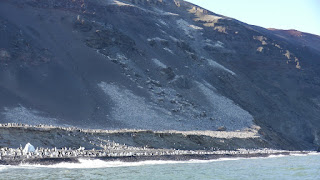 We
noticed a few penguins on the shore. And then started peering at the
pale areas further up the hill..........
We
noticed a few penguins on the shore. And then started peering at the
pale areas further up the hill.......... Spot
the seal. In the sea seals like to eat penguins, but on land the penguins are faster so there's an interesting truce of sorts.
Spot
the seal. In the sea seals like to eat penguins, but on land the penguins are faster so there's an interesting truce of sorts.
Penguins
live at sea where they feed, mainly on krill, in the ocean and hang
out on ice floes. They don't really like crowds and you mostly see
them alone or with a couple of others when you spot them on the ice.
They come to land to breed because they need a nice, warm, ice-free
surface for their nests so they can warm and hatch their eggs.
Because there's not a whole lot of ice-free land hereabouts they all
seem to end up in the same spot – a penguin rookery. This rookery
seemed to have millions of birds but there was probably only
thousands. The really big ones do literally have millions though.
And
they poo alot, covering their rookeries with "guano" (fancy
word for penguin poo) which is actually often harvested for
fertiliser. The rookery is covered in years and years and years worth
of the stuff.
And seals.
Parent
penguins like to make their chicks earn their food (and ensure it
really is their own chick and not an imposter) and compete against
their siblings so you see chases like this breaking out all over –
chicks chasing the parent looking for dinner.
 Notice the white toilet brushes that seem to be popular among the humans? – just the thing for scrubbing off the penguin poo
before heading back to your cabin.
Notice the white toilet brushes that seem to be popular among the humans? – just the thing for scrubbing off the penguin poo
before heading back to your cabin.
And
how do you round off a day at a penguin rookery? BBQ dinner! Though
they sensibly had this indoors, with waitstaff in casual dress, free
drinks and even mulled wine. Party time.
Day
22, 23 & 24. We moved north along the coast and got a little
taste of just how difficult a target Antarctica was for early
explorers, and even modern ones. Antarctica is pretty hard to get to.
It's quite far away from anywhere across a notoriously stormy and
cold sea. The land has tall, steep mountains which have a tendency to
plummet straight into the sea rather than having nice shallow
beaches. If you do find a nice landing spot there's probably a pile
of sea ice cutting you off from it. And if you find a nice landing
spot, without ice, it's probably too windy to make a safe landing.
We
hadn't been able to visit McMurdo Station (US research base) because
of the too much ice issue. As we came up the coast we missed our
chance to visit a small Italian base (which intuitively seemed like
it was going to be more fun) because of a big swell caused by the
big wind issue. We had to sail straight past the Possession Islands
because launching the zodiacs in the 40 to 50 knot winds (which I
think is about 80 to 100 km/h but I recommend you fact check that
one) is just not doable and missed Cape Hallett for the same reason.
Now
missing Cape Hallett was a particular blow because it's on the
mainland (as is the Italian station) and, believe it or not, we
hadn't set foot on mainland Antarctica yet at all. Everywhere else
had been islands. So we passed along the coast, admiring the stunning
scenery, spotting seals and penguins, and kept praying for the wind
to ease.
Birdspotters on the bow.
So
we're heading for Cape Adare, another stop on the Antarctic History
Nerd tour. This is the first place on the continent where people
overwintered back in (maybe) 1898/1899. There had been one previous
expedition a couple of years earlier that accidentally (or maybe accidentally on purpose with a conniving captain) overwintered
when their ship was frozen in the sea ice and they had to stay aboard
and wait for the ice to melt the following Spring, but no-one had
stayed on the mainland and no-one was really sure you could survive.
Ten men came ashore, (mostly Norwegian, a couple of Finns from
Lapland and one poor Aussie) built a hut and gave it a go. And they
survived. Well one didn't, he has the honour of being probably the
first man to die on the Antarctic Continent, but it was apparently of
natural causes and was not actually Antarctica's fault. My favourite
thing about this poor guy is he asked to be buried on the top of Cape
Adare so his colleagues had to drag his coffin all the way up and
ended up having to use dynamite to blow a grave in the frozen ground.
And their hut is still (mainly) standing! The other historical
connection with Cape Adare is that part of Scott's expedition (the
one where they all died) came here. The Northern Party of six men
came here, built a hut and spent a couple of months trying to explore
and chart the coastline and doing some science. Then they were picked
up by the ship and deposited further south for a quick stop off to do
similar work. Unfortunately the ship couldn't get back to pick them
up so they were stuck, without a hut or any provisions, having to
spend the Winter in an ice cave they made and survive on the seals
and penguins they managed to kill. The following Spring they walked
back to join the rest of the expedition (who, incidentally, had opted
to send a search party to find Scott et al's dead bodies rather than
trying to rescue their six maybe alive colleagues) at Cape Adare. This
was a really amazing survival story that got completely lost in the
celebration of the great dead heroes of the Pole.
Anyway,
we're on our way, our fingers and toes are all crossed (at least the
ones that haven't gone numb), we approach Cape Adare, we take a left
turn into the bay and.........the wind drops, the sea is glassy, we
get to go ashore!
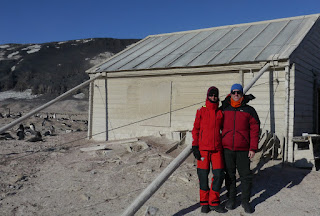 Borchgrevink's hut – it is
very tiny for ten men for a whole long, dark, cold Antarctic Winter but very well anchored down.
Borchgrevink's hut – it is
very tiny for ten men for a whole long, dark, cold Antarctic Winter but very well anchored down. A
drawing done by one of the men on the ceiling above his bunk – they
clearly had some time on their hands.
A
drawing done by one of the men on the ceiling above his bunk – they
clearly had some time on their hands. The
remains of Scott's party's hut – not quite as well constucted as
the Norwegian one it seems, but in fairness was only meant to be used
for a Summer season.
The
remains of Scott's party's hut – not quite as well constucted as
the Norwegian one it seems, but in fairness was only meant to be used
for a Summer season.
There
were lots of penguins as always but at this colony it seemed quite
late in the breeding season, there were packs of roaming adolescents,
and youths who had completed their molt were starting to learning to
swim. Alas there were also some little chicks who looked like maybe
they had been born too late in the season and just weren't going to
make it and had maybe already been ditched by their
parents......










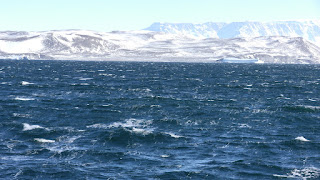


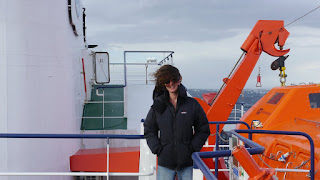











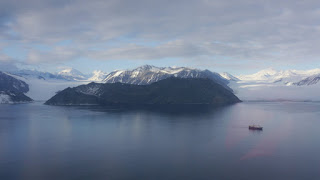
Comments
Post a Comment